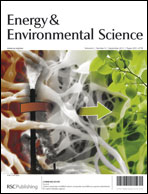On the role of intermixed phases in organic photovoltaic blends†
Abstract
Recently, an intermixed phase has been identified within organic photovoltaic (OPV) bulk heterojunction (BHJ) systems that can exist in addition to relatively phase-pure regions, highlighting the need for a refined picture of the solid-state microstructure of donor–acceptor blends and for gaining further understanding of the exact nature and role such intermixed phases play in such devices. Here we manipulate the microstructure of


 Please wait while we load your content...
Please wait while we load your content...